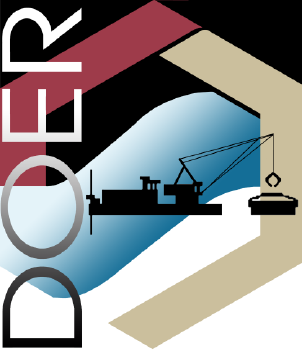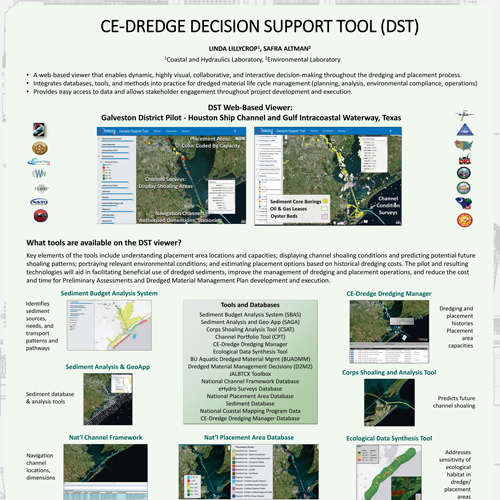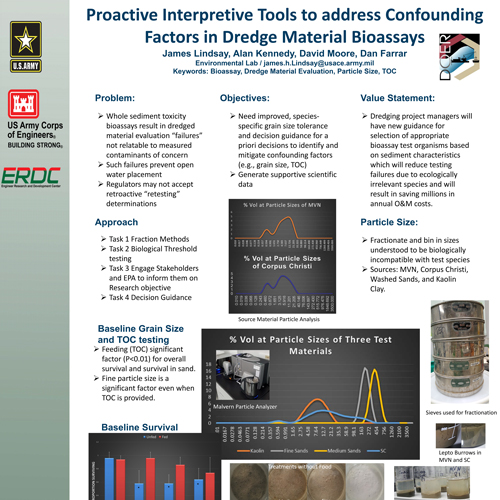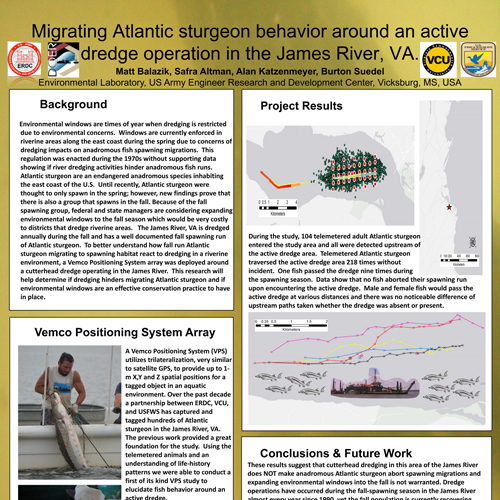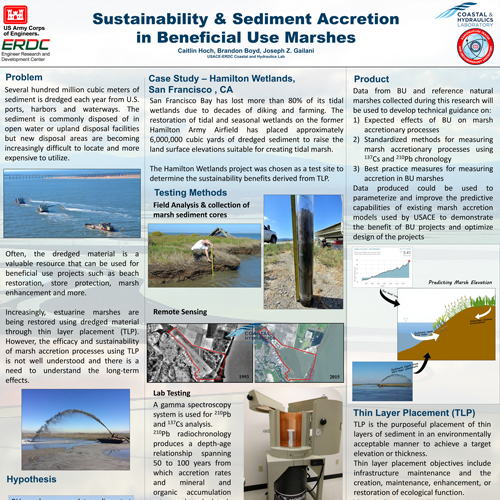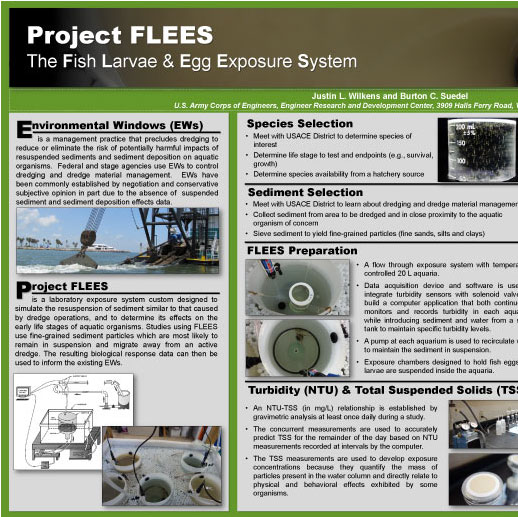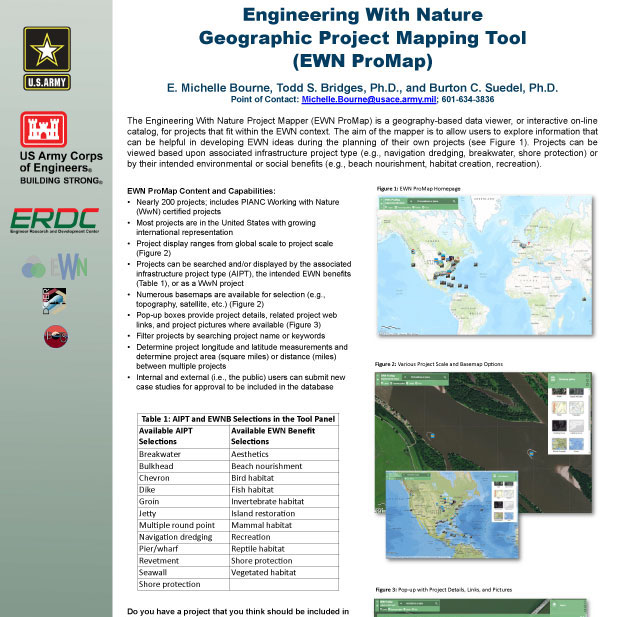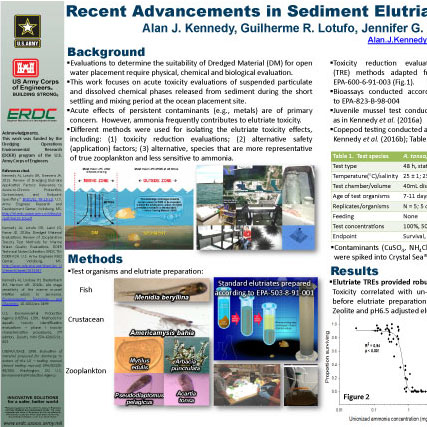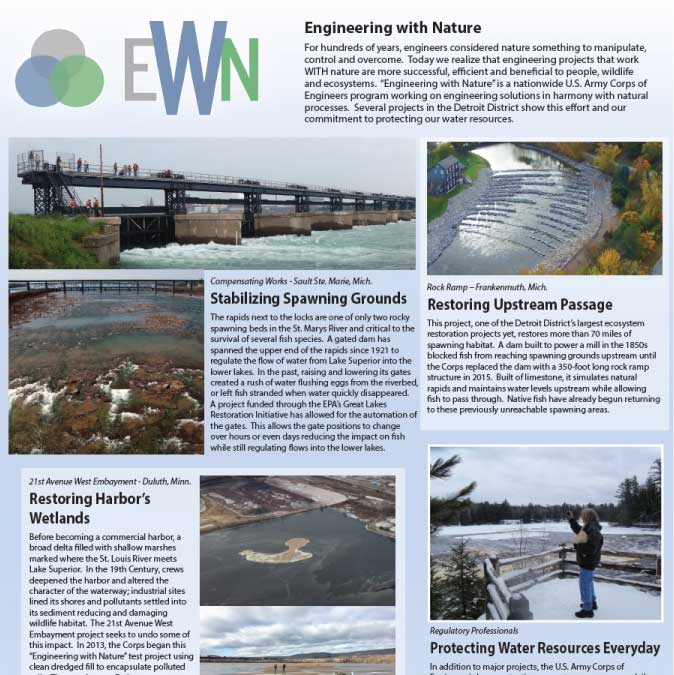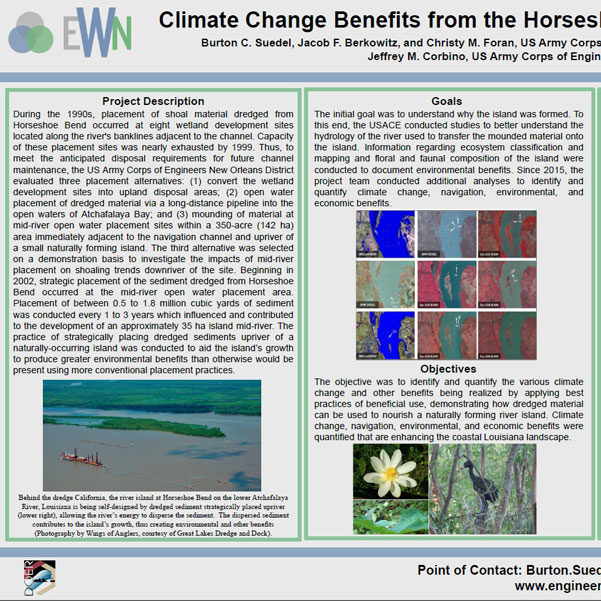Discover
A DOER infographic is a visual image or poster used to display information. This includes scientific poster presentations displaying DOER supported research or information about DOER capabilities.
Title: Assessing Sustainability and Ecosystem Support in Navigation Projects
Summary: Sustainability of the Navigation Mission requires a balance of three efforts: 1) reducing costs/impacts from the activity, in terms of both monetary and other resources, 2) increasing the potentially many types of benefit/value of the activity, and 3) aligning costs and benefits that accrue at different points and time. Case studies in Galveston and Cleveland are used to investigate project alternatives that attempt to maximize the beneficial use of dredged sediment and/or reduce the impact of sediment management activities to demonstrate potential sustainability improvements from removing specific inefficiencies or implementing specific improvements in terms of both operations and policy.
POC: Cate Fox-Lent and Matthew Bates
Title: Promoting marsh resiliency with dredged sediment in New Jersey: research and modeling applications
Summary: As part of a multi-partner demonstration project in response to Superstorm Sandy, the USACE Philadelphia District (NAP) dredged 45,000 CY of sediment from the New Jersey Intracoastal Waterway from November 2015 through February 2016 and placed it on 14 ha of a nearby marsh owned by the New Jersey Department of Environmental Protection (NJDEP). Placement depths ranged from a few centimeters to nearly 1 m in marsh pools to achieve the biological target elevation determined by the project partners.
POC: Susan Bailey , Jacob Berkowitz, Monica Chasten, Candice Piercy, Zachary Tyler, Christine VanZomeren and Timothy Welp
Title: CE-Dredge Decision Support Tool (DST)
Summary: A web-based viewer that enables dynamic, highly visual, collaborative, and interactive decision-making throughout the dredging and placement process. Integrates databases, tools, and methods into practice for dredged material life cycle management (planning, analysis, environmental compliance, operations). Provides easy access to data and allows stakeholder engagement throughout project development and execution.
POC: Linda Lillycrop and Safra Altman
Title: Proactive Interpretive Tools to Address Confounding Factors in Dredge Material Bioassays
Summary: Dredging project managers will have new guidance for selection of appropriate bioassay test organisms based on sediment characteristics which will reduce testing failures due to ecologically irrelevant species and will result in saving millions in annual O&M costs.
POC: James Lindsay , Alan Kennedy, David Moore, and Dan Farrar
Title: Migrating Atlantic Sturgeon Behavior Around an Active Dredge Operation in the James River, VA
Summary: Preliminary results from tracking telemetered Atlantic sturgeon near a cutterhead dredge operating in the James River, VA.
POC: Matt Balazik , Safra Altman, Alan Katzenmeyer, and Burton Suedel
Title: Sustainability and Sediment Accretion in Beneficial Use Marshes
Summary: Several hundred million cubic meters of sediment is dredged each year from U.S. ports, harbors and waterways. The sediment is commonly disposed of in open water or upland disposal facilities but new disposal areas are becoming increasingly difficult to locate and more expensive to utilize. Often, the dredged material is a valuable resource that can be used for beneficial use projects such as beach restoration, store protection, marsh enhancement and more.
POC: Hoch Caitlin , Brandon Boyd, and Joseph Gailani
Summary: This study successfully demonstrated the feasibility of: 1) deploying turtle tickler chains off a dredge drag-arm, and 2) the ability to monitor equipment in turbid waters by mounting of an underwater acoustic camera to a drag-arm.
POC: Dena Dickerson , Tim Welp, Stephen Willis, Doug Novy, and John Henrikson
Title: Project FLEES
Summary: Project FLEES is a laboratory exposure system custom designed to simulate the resuspension of sediment similar to that caused by dredge operations, and to determine its effects on the early life stages of aquatic organisms. Studies using FLEES use fine-grained sediment particles which are most likely to remain in suspension and migrate away from an active dredge. The resulting biological response data can then be used to inform the existing EWs.
POC: Justin L. Wilkens and Burton C. Suedel
Title: Engineering With Nature Geographic Project Mapping Tool (EWN ProMap)
Summary: The Engineering With Nature Project Mapper (EWN ProMap) is a geography-based data viewer, or interactive on-line catalog, for projects that fit within the EWN context. The aim of the mapper is to allow users to explore information that can be helpful in developing EWN ideas during the planning of their own projects. Projects can be viewed based upon associated infrastructure project type (e.g., navigation dredging, breakwater, shoreprotection) or by their intended environmental or social benefits (e.g., beach nourishment, habitat creation, recreation).
POC: E. Michelle Bourne, Todd S. Bridges, Ph.D., and Burton C. Suedel
Title: Recent Advancements in Sediment Elutriate (Dredged Material) Water Column Evaluations
Summary: Evaluations to determine the suitability of Dredged Material (DM) for open water placement require physical, chemical and biological evaluation. This work focuses on acute toxicity evaluations of suspended particulate and dissolved chemical phases released from sediment during the short settling and mixing period at the ocean placement site.
POC: Alan J. Kennedy, Guilherme R. Lotufo, Jennifer G. Laird, James Lindsay, James M. Biedenbach, and J. Daniel Farrar
Title: Engineering With Nature: USACE Detroit District
Summary: For hundreds of years, engineers considered nature something to manipulate, control and overcome. Today we realize that engineering projects that work WITH nature are more successful, efficient and beneficial to people, wildlife and ecosystems. “Engineering with Nature” is a nationwide U.S. Army Corps of Engineers program working on engineering solutions in harmony with natural processes. Several projects in the Detroit District show this effort and our commitment to protecting our water resources.
POC: Michelle Briggs and Burton C. Suedel
Title: Climate Change Benefits from the Horseshoe Bend Engineering with Nature Project
Summary: The objective was to identify and quantify the various climate change and other benefits being realized by applying best practices of beneficial use, demonstrating how dredged material can be used to nourish a naturally forming river island. Climate change, navigation, environmental, and economic benefits were quantified that are enhancing the coastal Louisiana landscape.
POC: Burton C. Suedel
Last updated on 12/17/2024.
